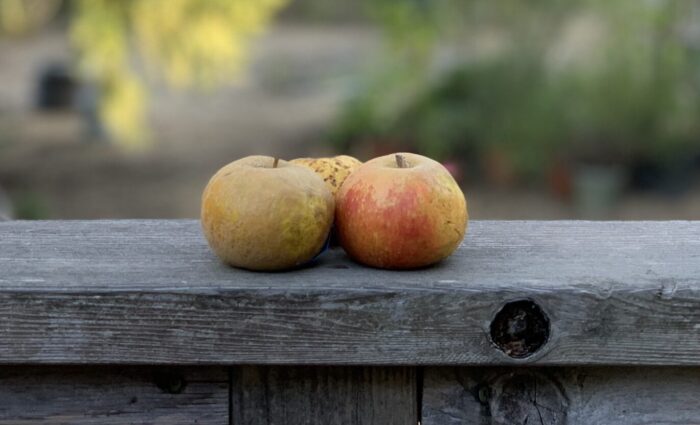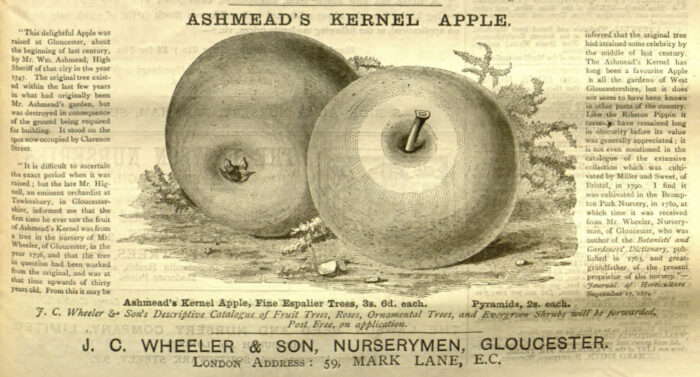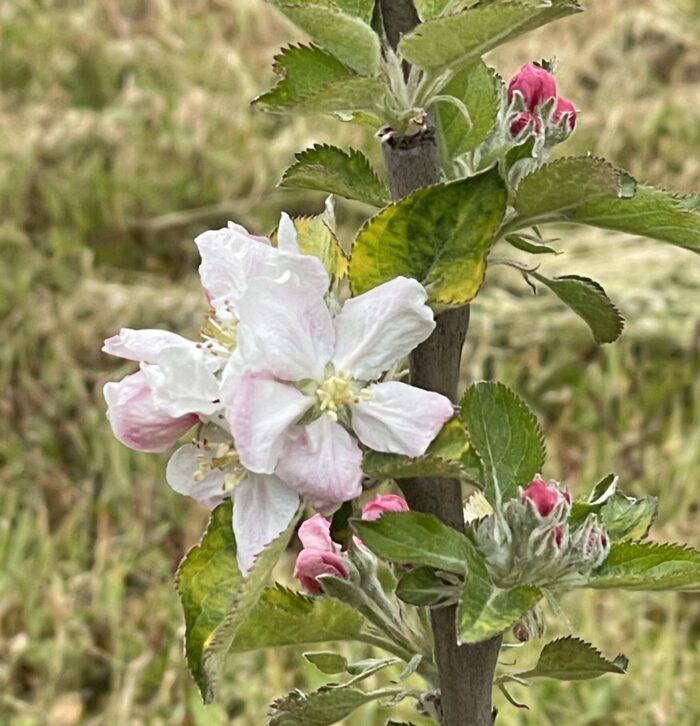Some stories don’t come that easily, and the Ashmead’s Kernel story turned out to be one of them.
Part of the problem is its documented history, or lack thereof. Uncovering the history of a centuries old apple always has challenges. Contemporary documents that reference it may be lost, or may have never existed. Diary entries that read “the apple seed that I planted 10 years ago in the back corner of the garden has turned out to bear quite tasty fruit” are few and far between. Once the apple has gotten some notice, those who write about it are often not very good at chronicling its origins except in the barest of ways.
The tree that became Ashmead’s Kernel is believed to have been planted early in the 18th century. A hundred years later, pomological writers attributed its origin to a Mr. Ashmead of Gloucester, a Dr. Ashmead of the Gloucestershire village of Ashmeads, or, splitting the difference, a Dr. Ashmead of Gloucester, “an eminent physician of that city,” an embellishment added by the writer, Robert Hogg. Finally, in 1861, the Reverend Samuel Lysons gives Ashmead a first name, “William Ashmead, some time town clerk of this city [Gloucester], who planted the first tree near Clarence street,” mentioned in a lecture on the topic of “What has our county done?” Helpful, but not much for there were any number of Ashmeads owning lands and living in and around Gloucester in the 18th century, several of whom were named William. Most of the folks that care about such things in Gloucestershire today believe the William was an attorney and as such may have been a doctor of laws, which would account for the honorific. This William Ashmead was born in 1721, married Mary Jones in 1759, and died, childless, in 1782. Not much story there.
The English have a reputation for being a little gardening mad, and it was more or less during the reign of George III (1760-1801) that this madness started to take off. New and exotic plants were flooding into England from far flung spots around the globe, brought back by explorers, colonizers, and scientists. These thousands of discoveries were fueling new ways of thinking about the natural world, including how it could be organized and systematized, and there were any number of competing systems. The one we still use today, with some modification, was created by a Swede named Carl von Linné. We know him by his latinized name, Linnaeus. Popular books explaining the Linnaean system began to appear in England in the 1760s sparking an ardent interest in botanizing, meandering walks through the fields with guide in hand followed by exclamations of delight in finding a particular specimen. It was the perfect pastime for the well-bred young lady who might, if she had the inclination, pause to make a sketch that could later be turned into a watercolor.
One of those popular books was written by Gloucester nurseryman James Wheeler in 1763 around the same time that he began growing and selling trees grafted from Ashmead’s apple. Founding his nursery in 1750, Wheeler was part of the expansion of nurseries outside of London that catered to the middle class, those that had caught the gardening bug and wanted both plants and fruit trees for their gardens. He clearly had connections with the London nurseries, which may be where he learned of Linnaeus, for he sent Ashmead’s Kernel scions to the earliest and arguably the best known nursery, Brompton Park, in the 1780s. Without Wheeler’s intervention, Ashmead’s Kernel may well have ended its days as just another obscure local apple.
After Brompton Park it entered the ever expanding collection of the Horticultural Society of London assembled at Kew Gardens (it appears in their 1826 listing of varieties) and started to make its way out into the wider world. A Mr. Holbert’s Ashmead’s Kernels won the dessert apple prize at the Vale of Evesham Horticultural and Floral Society competition in 1834. They were offered for sale by name in Manchester in 1835. A notice placed by J. Cheslin Wheeler (on of James’ sons) in a January 1849 issue of The Gardeners’ Chronicle announcing the availability of “True Ashmead’s Kernel” trees suggests that by then the unscrupulous were passing off inferior varieties as the original from Gloucester. It is tempting to think that it came to the US in one of the exchanges made between the agriculturalist Jesse Buel and the Horticultural Society of London, for it was being grown in New York by 1851. Still, Ashmead’s Kernel never quite caught on in America the way it did in England, maybe because of a bias toward American varieties. It is seems to be more widely grown now.
It isn’t a particularly large apple. Its ground color is green with a yellow overcast and flushes of orange or red, sometimes in stripes, on its sun side. It is always russeted to some degree, but its shape can vary considerably from round to oblate to conical. As to flavor, Ashmead’s Kernel has very passionate fans. One of the best descriptions comes from a talk on apples given by journalist and food writer P. Morton Shand on BBC Radio in 1944. “What an apple, what suavity of aroma” he said. “Its initial Madeira-like mellowness of flavour overlies a deeper honeyed nuttiness, crisply sweet not sugar sweet, but the succulence of a well devilled marrow bone. Surely no apple of greater distinction or more perfect balance can ever have been raised anywhere on earth.”
How, then, does this well loved dessert apple behave when fermented? The five we tried (I was joined by former Golden State Cider cidermaker Tim Godfrey) were all pretty tasty with a healthy dose of acid, no discernible tannin, and body that varied from some to a lot. Lime or some other tart citrus seemed to be the common flavor theme. What intrigued us the most, though, were the ones that were a little bit resiny, with aromas and flavors of fir or juniper. Most interesting.
Sundström Cider, Hudson Valley, NY – dry; fir tips, juniper, ripe pear, lime juice, lychee, grapefruit; still; 2016; 10% ABV
South Hill Ciders, Ithaca, NY – dry; grapefruit peel, fir tips, tropical fruit, citrus; sparkling; 2019; 10.7% ABV
Chatter Creek Cider, Seattle, WA – dry; lime zest, mint, menthol, juniper, plum skin, green apricot, citrus pith, green herbs; sparkling; 2019; 9.5% ABV
Haykin Family Cider, Aurora, CO – semi-sweet; limeade, plum skin, mango, lemon juice and pith, grapefruit juice, cranberry; sparkling; 2017; 7.3% ABV (apples grown in Yakima, WA)
Wise Bird Cider Co., Lexington, KY – dry; green plum skin, pear skin, lemon juice, just ripe peach, grapefruit, lychee, green leaf; sparkling; 2019; 8.4% ABV


